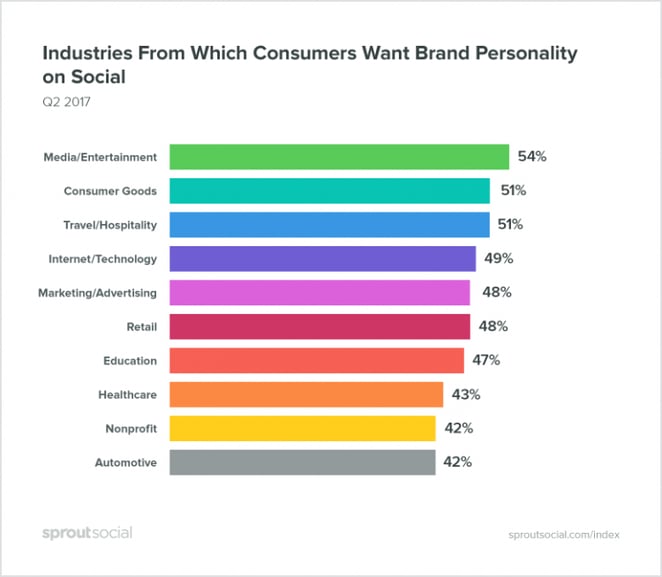How does your brand image play online? Interview with Jonathan Lemay, Practice Lead, Brand and Content
How do consumers perceive your brand online? You might have gotten a sense through word of mouth, a survey sent in your last newsletter or maybe by talking to your customer service department.
Building brand perception happens across multiple channels, and these days factoring in the impact of digital is no longer optional. Beyond your employees, your customer service department, your logo and even your content marketing, the number of channels available has boomed over the past few years, and changed the way companies need to approach brand strategy.
I sat down with Jonathan Lemay, Practice Lead, Brand and Content, to discuss online brand image.
What’s the influence of digital on brands?
I would say that these days I see a dichotomy: the majority of brands that weren’t born into digital, for example retail products and major supermarket chains, still haven’t entirely mastered the jump to digital. Brands that grew up with traditional marketing still have a hard time expressing themselves and adopting good digital practices.
As a marketer, I’ve noticed that there’s a persistent inability among the employees of these companies to integrate digital. Yet, there are brands that have built their credibility solely on the web and still others that owe their success to social media.
I recently read a LinkedIn article that mentioned that despite declining numbers of users on social media, brands will be the last to abandon ship. I get the impression that brands are both the last to jump onto digital trends, and the last to walk away.

It’s hard for brands to adopt behaviour faster than consumers. Behaviour needs to be adopted by the majority before a brand can get on board. For example, a user who is familiar with a particular social platform will know exactly how it works, and what the conventions are, while a brand getting into social media will have a steeper learning curve and less time to adapt. That said, some natively digital brands do this quite well.
Do you think some brands are afraid of using humour, even self-deprecating humour, in their web content for fear of the repercussions on their brand image?
Many brands are hesitant to let users shape their brand image. Company founders often have a very narrowly defined, fixed vision of their brand, because their marketers dictated a specific direction, but the reality now with digital is that content that lives on the web is open to feedback from consumers, which they are never shy to share.
People’s responses, emotions and perceptions live in perpetuity online, and your digital footprint already exists. People will either use words, or their behaviour will do the talking. It’s important to capture these reactions and not just let them slide, otherwise you risk losing hugely valuable opportunities for data analysis.
It can seem difficult as a company to accept that feedback can come at any time, unlike the processes linked to quarters or years. It’s therefore very difficult to get a fixed idea of what consumers want in real time, because there’s no beginning or end to the feedback generated by social media.
How can you know if consumers like a brand?
The first thing to do, as mundane as it may seem, is take a look at your own social media. Most brands now have a significant social presence, so it makes sense to see what people are saying about you. Pay attention to your own platforms by analyzing how people react to your posts, as well as to your competitors. There are three possible types of sentiment: positive, negative or neutral. It’s easiest to identify the people who like or hate you, and make adjustments accordingly. In a sense, the people who are neutral towards you, or worse, haven’t noticed you at all, are the worst of the three, because they don’t leave a trace on the web.
There are three possible types of sentiment: positive, negative or neutral.
A second element to consider to know if your brand is being well received is to observe users’ behaviour on your website. Did they find what they were looking for? Were they drawn in to the point of signing up for your newsletter? All these elements need to be factored into the equation. If it interests you, my colleague Marion Peres wrote a fascinating article about user insights!
Finally, you need to check out other platforms where some of your users might speak out, for example forums, or even your competitors’ platforms. If the conversation around your brand isn’t happening on the channels you built, you need to ask yourself whether something has gone wrong.
At what point would you recommend that a company should think about reworking its brand?
For many companies, it starts with a catalyst. For some that’s a competitor taking the lead in the market, while for others it’s a drop in sales. It’s only then that the intention to make a change takes hold. And although the reflex is a good one, it’s usually better to start the process earlier. As soon as a company is more reactive than proactive, they have a lot of catching up to do. However, it’s entirely possible to use this observation to your advantage to plan for the future in a solid way, and not just temporarily. We need to get out of the reactive mindset and establish processes and technologies that will allow us to grow our brands, understand what our customers truly need, analyze how the competition is evolving and then measure the results of our actions.
What advice would you give to a company that wants a strong online brand image?
First of all, I would say focus on the consumer. I’m a firm believer that bringing in an external partner is the best way for a company to get an accurate sense of the needs being expressed by the target market. A strategist’s work consists of knowing what the user is looking for, what they need and what they like. More specifically, a strategist wants to know where the consumer is in the buyer’s journey. By incorporating the client’s expertise on their product and business goals, a digital strategist will be able to identify opportunities for where and how to reach the target audience.
Secondly, it’s important to have a good dose of humility. When you’re at the head of a company, you put your heart and soul into it, and often believe you’ve got the best product on the market. It can also be easy to come to the conclusion, however unfounded, that you know exactly what your customer wants. We ignore the fact that others are probably doing things better than us, or at least differently. And even if you are the best on the market, there’s still room for learning and improvement.
By constantly observing the behaviour of users and competitors, it becomes possible to correct course and make plans with an eye to differentiation. Humility means accepting that you might not be the best, owning your faults and living in a competitive environment. It also means accepting and being comfortable with the direction you’ve chosen, while being aware that your competition will take a different direction that’s just as valid for the consumer.
Humility means accepting that you might not be the best, owning your faults and living in a competitive environment.
The lifespan of messaging is getting shorter and shorter. Launching a strategy based on common internal perceptions represents, on the one hand, a comfortable choice because there will be very few dissenting voices. That said, on the other hand it represents an enormous risk because it excludes the most important voice, the voice of the consumer, which may well be a voice of dissent.
Lastly, I would recommend always testing and adjusting. Thirty years ago, it was more complicated for a company to change directions after booking slots with broadcasters. Today, many companies take advantage of the flexibility of digital to test multiple ads with test audiences. They adjust their messages and images based on user feedback, and in so doing, limit the positive or negative impact of the content to just those test groups. Finally, companies can better understand what consumers like, and use only the content that performed best with test audiences. That’s exactly what we did with our client Lassonde for the launch of a new format for Oasis.
In 2018, companies that are well established in digital stand out with strong, unique voices. How can a company find its voice in digital?
It’s fairly difficult to find your own voice in digital today. Almost everything has been tried or thought of. Finding your voice, expressing your values and mission is no small feat, and it’s the execution that allows you to differentiate yourself in the market. Brand expression today needs to include digital, and by having a strong foundation you can make things interesting and stand out from the crowd.

An example I like to use is that of a comedian talking about their everyday life during a show. There are countless comedians who do this, and there will doubtless be countless more. That said, there’s a huge difference in interpretation between the person telling their anecdote in a barking, ironic way versus the person using a smooth, seductive tone of voice. Two people can tell the same story but occupy two different niches and therefore appeal to different audiences, or possibly the same audiences but for different reasons.
For brands, the situation is often identical. There are tons of companies addressing the same target markets, telling similar stories. The difference is in the execution. When companies can tell their stories in a creative way, they are able to stand out and add value. I am of the opinion that creativity still has an enormous role to play in digital, but that it’s still possible to add a touch of personalization through the use of the data brands have access to on the web to make a real difference in the market.
Want to go farther? Read this article for tricks to establish a content strategy based on your customer data. To learn more on our approach to brand and content, check out the full scope of our services, or contact us!



.jpg)





